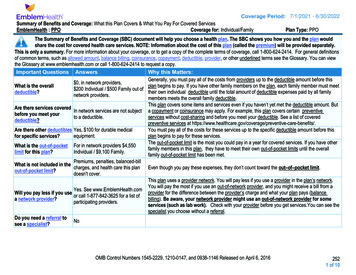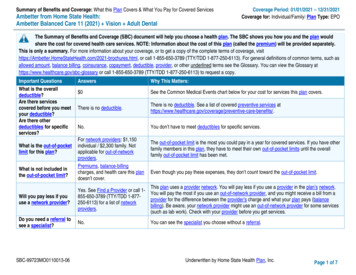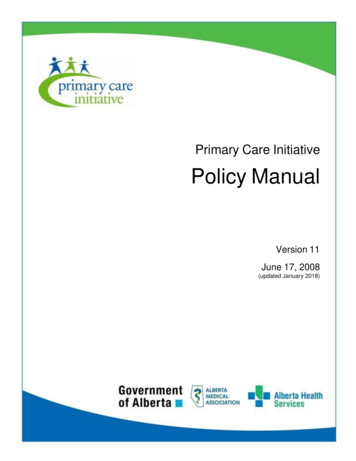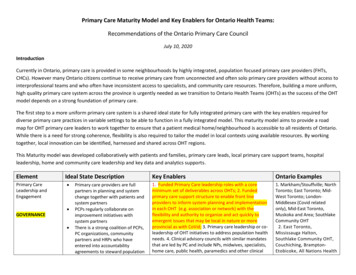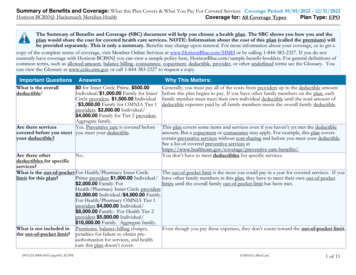
Transcription
(2021) 21:1300Postali et al. BMC Health Services Open AccessRESEARCHPrimary care coverage and individualhealth: evidence from a likelihood model usingbiomarkers in BrazilFernando Antonio Slaibe Postali1*, Maria Dolores Montoya Diaz1, Natalia Nunes Ferreira‑Batista2,Adriano Dutra Teixeira3 and Rodrigo Moreno‑Serra4AbstractBackground: Although the use of biomarkers to assess health outcomes has recently gained momentum, literatureis still scarce for low- to middle-income countries. This paper explores the relationship between primary care coverageand individual health in Brazil using a dataset of blood-based biomarkers collected by the Brazilian National HealthSurvey. Both survey data and laboratory results were crossed with coverage data from the Family Health Strategy(ESF) program, the most important primary care program in Brazil; the coverage measures aim to capture both direct(household) and indirect (spill-over) effects.Methods: The empirical strategy used a probit model to estimate the relationship between ESF program coverageand the likelihood of abnormal biomarker levels while controlling for a rich set of individual and household character‑istics based on data from the national survey.Results: Household ESF coverage was associated with a lower likelihood of abnormal results for biomarkers relatedto anemia (marginal effect between 2.16 and 2.18 percentage points), kidney failure (between 1.01 and 1.19p.p.), and arterial hypertension (between 1.48 and 1.64 p.p). The likelihood of abnormal levels of white blood cellsand thrombocytes was negatively related to primary care coverage (marginal effect between 1.8 and 2 p.p.). Thespillover effects were relevant for kidney failure and arterial hypertension, depending on the regional level. Althoughnot sensitive to household coverage, diabetes mellitus was negatively associated with the state supply of primarycare, and abnormal cholesterol levels did not present any relationship with ESF program coverage.Conclusions: The presence of spillover effects of ESF program coverage regarding these conditions reveals that thestrengthening of primary care by increasing the household registration and the regional density of ESF teams is anefficient strategy to address important comorbidities.Keywords: Primary care, Biomarkers, Probit, Impact evaluation, Universal health care, Low- to middle-incomecountries*Correspondence: postali@usp.br1Department of Economics, University of Sao Paulo, Avenida Prof.Luciano Gualberto, 908, São Paulo, SP 5508‑010, BrazilFull list of author information is available at the end of the articleBackgroundThe Family Health Strategy (ESF) program is the largest primary health care program in Brazil. Launched in1993, the ESF program has, over the past two decades,spread gradually across Brazilian municipalities as part ofa strategy to strengthen basic health care attention. Theprogram is structured by health teams comprising one The Author(s) 2021. Open Access This article is licensed under a Creative Commons Attribution 4.0 International License, whichpermits use, sharing, adaptation, distribution and reproduction in any medium or format, as long as you give appropriate credit to theoriginal author(s) and the source, provide a link to the Creative Commons licence, and indicate if changes were made. The images orother third party material in this article are included in the article’s Creative Commons licence, unless indicated otherwise in a credit lineto the material. If material is not included in the article’s Creative Commons licence and your intended use is not permitted by statutoryregulation or exceeds the permitted use, you will need to obtain permission directly from the copyright holder. To view a copy of thislicence, visit http:// creat iveco mmons. org/ licen ses/ by/4. 0/. The Creative Commons Public Domain Dedication waiver (http:// creat iveco mmons. org/ publi cdoma in/ zero/1. 0/) applies to the data made available in this article, unless otherwise stated in a credit line to the data.
Postali et al. BMC Health Services Research(2021) 21:1300physician, one nurse, one auxiliary nurse, and four to sixcommunity health agents. Community health workersare responsible for periodic home visits to local residentsto assess their general health conditions and, if necessary,to give them referrals to outpatient clinics, where the restof the team members are based.Most of the existing literature on the topic assessesthe impact of the ESF program [1], finding evidencethat it has succeeded in reducing infant and/or maternal mortality [2–7], the mortality rates of some diseasesand comorbidities [8–11], and admission to outpatient clinics and hospitals due to primary care-sensitiveconditions [12–15]. However, a gap has been found inthis literature, as the channels whereby the ESF program’s actions affect individual health have not receiveddeserved attention.Up to 2008, every 5 years, the Brazilian Institute forGeography and Statistics (IBGE) included a special supplement on health in its Annual National HouseholdSample Survey (PNAD) with specific questions regardingthe health of the population. From 2013 onward, this special supplement on health was converted into a broaderseparate survey called the National Health Survey (PNS).It contained more than 700 questions grouped into 21themes, including children’s health, women’s and elderlypeople’s health, chronic diseases, oral health, eating habits, smoking habits, physical activity, health insurancecoverage, search for medical services, hospital or outpatient clinics, household income, visits by communityagents (including ESF program), and self-assessment ofhealth, among other themes [16].1The PNS 2013 collected anthropometric measures (weight, height, and waist circumference) fromhousehold representatives and measured their bloodpressure. A subsample of surveyed household representatives was assigned to attend a laboratory clinicto collect biological material (blood and urine) to betested for some biomarkers. In total, 8952 adult individuals over the age of 18 years had their biologicalmaterial collected. The following laboratory tests wereperformed [18]: a hemogram and its components (redblood cell, white blood cell and platelet counts); glycated hemoglobin and estimated average blood glucose levels; total cholesterol levels and fractions (HDLand LDL); serial creatinine levels (from which the glomerular filtration rate was calculated [19]); and a serology test for dengue (IgG). The excretion of creatinine,potassium, salt, and sodium was estimated in the urinesamples [18]. The data of individual tests were madepublicly available on the Oswaldo Cruz Foundation’s1For details on the sample design of the PNS 2013, see [17].Page 2 of 8PNS website [20].2 The information on biomarkers inthis dataset3 represents a unique opportunity to contribute to the understanding of the individual channelsof the ESF program’s impact on the prevalence of somediseases.Most of the studies with biomarkers and health interventions focus on high-income countries and covera wide range of purposes and methods [23–32]. Thisstudy aimed to contribute to a better understandingof the channels by which the ESF program affects individual health in Brazil using the results of the laboratorytests described above. The main goal was to investigate whether there is any relationship between primaryhealth care and the biomarkers of the examined individuals. To the best of our knowledge, this is the first studythat adopts this strategy to try to unveil the mechanismsthrough which primary care coverage may impact healthin Brazil.MethodsThe set of diseases and comorbidities assessed in thisstudy was limited by the blood-based biomarkers andthe exams contained in the laboratory tests, focusing onconditions that are sensitive to primary care [33]. The following health problems were investigated: leukopenia,leukocytosis, diabetes mellitus, hypercholesterolemia,kidney failure, anemia, thrombocytopenia, and arterial hypertension. Charts S1 and S2 in the AdditionalFile 1 list the corresponding biomarkers, their ranges forabnormal results and the proportion of tests according tothe defined ranges.As the laboratory results were made available separately from the PNS 2013 survey, it was necessary toadopt a procedure for merging both datasets to associate each biomarker level with the corresponding interviewed individual. To this end, an identification key wasbuilt based on the following information presented inboth datasets: weight, height, sex, age, ethnicity, healthself-evaluation, and level of education. The identificationkeys were complemented with specific questions (doctor appointments, nourishment, and health insurance)to maximize the key variability and the percentage ofmatches. This key proved to have a success rate of 99.8%:from the 8952 individuals tested, only 17 did not match.2The second edition of the PNS was carried out in 2019, but no laboratorytests were conducted in this edition.3All data used in this study were made publicly available on the internet[20–22] by the institutions responsible for collecting the data, so no ethical approval was required. The Brazilian legislation (Resolution 510, of April7, 2016, from the National Health Council/Health Ministry) establishes thatstudies that use information with public access will not be registered orevaluated by the Research Ethics Committee. This study fits into that category.
Postali et al. BMC Health Services Research(2021) 21:1300As the PNS allowed for the identification of the stateand, if applicable, the metropolitan area that each surveyed household was in, it was possible to associateeach laboratory result to the regional supply of the ESFteams.4 This represented an opportunity to assess potential positive externalities of the program. The hypothesisto be tested was whether a higher supply of health primary care services, measured by the number of the ESFteams by 10,000 inhabitants near the household, implieda more effective result because nonregistered individualscould benefit indirectly from spillover effects producedby health interventions [34, 35]. Therefore, in addition toassessing the direct channels by which the ESF programaffects individual health, this study aimed to contributeby testing whether there was an indirect effect comingfrom the density of the ESF teams within the state or themetropolitan area in which the individual lived.To do so, the measure of coverage was disaggregatedinto two direct dimensions and one indirect dimension,as follows:ESF registration: This is a binary variable (dummy) thatequals one if the household was registered in the ESF program and zero otherwise, according to the individual’sanswer in the PNS 2013. This variable is a measure of coverage and captures the direct effect of being assisted by anESF team.ESF visits: This is the number of annual visits receivedby the household. The survey asked how often an ESFagent visited the household in the 12 months prior to thesurvey, and the number of visits was calculated accordingto the option chosen by the respondent. This variable wasincluded to evaluate whether the intensity of primary carecoverage had any relationship with the laboratory results.ESF program supply: This is the number of ESF teamsby 10,000 inhabitants deployed to the metropolitan areaor to the state in which the respondent dwelt in 2013(source: Datasus [21]).The answers from the PNS allowed us to include threemain sets of control variables5:Individual characteristics: sex, age, ethnicity, maritalstatus, highest educational level (completed high schoolor completed college), individual health insurance,4While the PNS does not identify the surveyed municipalities, its designallows the identification of whether a household is located in a metropolitanarea. As created by the law, metropolitan areas are clusters of urban cities thatcoordinate joint actions of development and set up unified policies to addresscommon problems. According to the last Brazilian National Census (2010),approximately 40% of the Brazilian population dwelt in 21 metropolitan areasaround the state capitals. Among the 8900 individual lab tests, there was asubsample of 3879 collected across 21 identifiable metropolitan areas.Page 3 of 8smoking status and practice of physical activity at leastonce a week.Individual health conditions: obesity (individuals witha Body Mass Index 30 kg/m2); waist circumference; aprevious diagnosis of the following conditions: chronicdisease, kidney failure, heart condition, diabetes, cancer and/or high blood pressure; and if the individual washospitalized in the 12 months prior to the survey.Household characteristics: household income per capita, participation in the federal cash transfer program(Bolsa Familia), and the presence of piped water, electric power, sanitation, and/or garbage collection. Thesecovariates aimed to control for socioeconomic characteristics that affect health. The descriptive statistics of bothcoverage and control variables can be found in Tables S1and S2 in the Additional File 1.Additionally, the number of hospital beds per capitawas included to control for the regional/local supply ofhealth facilities (Source: Datasus [21]).The final number of individuals tested was below theactual drawn number due to logistic difficulties, whichrequired a poststratification procedure. Sampling weightswere calculated for use of the laboratory exam dataset,given the poststratification procedures by sex, age, ethnicity, and educational level according to large regions,from the total sample of the PNS [18]. Fiocruz releasedthe weights of the laboratory exams, which were used toweigh the standard deviations of the estimates [18].The relationship between ESF program coverage andindividual health was estimated through a probabilitymodel, in which the dependent variable presented thelikelihood of an abnormal biomarker level. The probitmodel can be generically expressed as (1):()()Pr y 1 X Φ 𝛽1 ESFregistration 𝛽2 ESFvisits 𝛽3 ESFsupply X𝛾(1)where y is the binary variable equal to one if the result ofthe individual laboratory test is out of the reference rangefor the corresponding biomarker (Table S1 – AdditionalFile 1) and zero otherwise, and X is the vector containingthe set of controls. Φ(.) is the cumulative of the standardnormal distribution.ResultsTables 1, 2, 3, 4 present the results for the likelihood ofabnormalities in biomarkers, expressed as probit marginal effects.6 With the purpose of assessing both directand indirect effects, the estimates were grouped by thefour types of coverage. Specification I took the full sample65Nonquantitative characteristics were measured through binary variablesthat assumed value one if the individual fulfilled the characteristic and zerootherwise.The marginal effect means the change in the likelihood of a disease/comorbidity given a small change in the explicative variable. For binary explicativevariables, the marginal effect must be interpreted as the change in the likelihood of disease if the explicative variable changes from 0 to 1.
Postali et al. BMC Health Services Research(2021) 21:1300Page 4 of 8Table 1 Results considering only household coverage (Spec. I)Leukopenia Leukocytosis DiabetesMellitus 0.0186**HighCholesterolKidney Failure Low Platelets Anemia0.00287 0.0119**ESF registration 5)(0.0056)(0.00982)(0.00797)ESF visits0.00180*0.0002660.000454(0.0009) 0.0002470.00141***(0.00095) 0.000382 0.000893 0.00043Health facilities 0.00404*** 0.0143***Observations 0.00847 0.0137**ArterialHypertension 0.0216** 975)(0.000785) 0.0079*** 0.000729 0.00106* 31883188318831883188318831Weighted standard errors are in parentheses; *** p 0.01, ** p 0.05, * p 0.1. All results were controlled for the individual characteristics (sex, age, ethnicity, maritalstatus, educational level), individual health conditions (obesity, waist measure, previous diagnosis of chronic diseases, kidney condition, heart condition, diabetes,cancer, high blood pressure, hospitalized in the previous 12 months), household characteristics (presence of piped water, electric power, sanitation, garbagecollection, household income per capita), whether the individual was covered by health insurance or not, if they are were Bolsa Familia recipient or not, if theyparticipated in sports or not, and if they were a smoker or not.Table 2 Results considering household coverage and metropolitan ESF supply (Spec. II)Leukopenia Leukocytosis DiabetesMellitusESF registrationESF visitsHighCholesterolKidney Failure Low Platelets AnemiaArterialHypertension 0.0203* 0.0209* 0.0103 0.00515 0.00877 0.0107 0.00766 .007)(0.0137)(0.0107) 0.000880.000526 7.67E-05 0.000101 0.000493 li0.00889tan ESF supply 0.0160 0.00341 0.00447 0.0168***0.00706 0.0607*** 0)(0.006)(0.0122)(0.0099) 0.00069 0.0059*** 0.0049*** 0.000430.000259 0.000030.00592*** 384038403840Health facilitiesObservationsWeighted standard errors are in parentheses; *** p 0.01, ** p 0.05, * p 0.1. All results were controlled for the individual characteristics (sex, age, ethnicity,marital status, educational level), individual health conditions (obesity, waist measure, previous diagnosis of chronic diseases, kidney condition, heart condition,diabetes, cancer, high blood pressure, hospitalized in the previous 12 months), household characteristics (presence of piped water, electric power, sanitation,garbage collection, household income per capita), whether the individual was covered by health insurance or not, if they were a Bolsa Familia recipient or not, if theyparticipated in sports or not, and if they were a smoker or not. The metropolitan ESF supply was measured as the number of local ESF teams by 10,000 inhabitants atthe metropolitan level.into account and considered only household coverage(ESF program registration and ESF visits); Specification IIconsidered only individuals that were tested in metropolitan areas with household coverage and metropolitan ESFsupply, as defined in the previous section; SpecificationIII took into account all individuals that were tested withhousehold coverage and the corresponding state ESF supply; and finally, Specification IV considered the full sample and household coverage (as Spec. I) but replaced theregional health facilities with binary variables that identified the state or, if applicable, the metropolitan area therespondent dwelt in, with the purpose of capturing thespecific regional effects.Table 1 exhibits the results for Specification I. Except fordiabetes mellitus and high cholesterol, being registered inthe ESF program was associated with a lower likelihood ofabnormal ranges of biomarkers linked to all comorbidities.Kidney failure had the smallest marginal effect, i.e., the likelihood of observing an abnormal biomarker for this healthcondition was approximately 1.19 p.p. lower in registeredindividuals than in nonregistered individuals, whereas thelikelihood reached 2.16 p.p. for anemia. Although beingregistered in the ESF program was negatively associatedwith the likelihood of thrombocytopenia (marginal effect of 1.37 p.p.), the number of visits, on the other hand, waspositively associated with the likelihood of this comorbidity.
Postali et al. BMC Health Services Research(2021) 21:1300Page 5 of 8Table 3 Results considering household coverage and state ESF supply (Spec. III)Leukopenia Leukocytosis DiabetesMellitusESF registrationESF visitsState ESF supplyHealth facilitiesObservationsHighCholesterolKidney Failure Low Platelets AnemiaArterialHypertension 0.0209** 0.0187** 0.00780.00236 0.0118** 0.0137** 0.0218** 0.0009)(0.00068) 0.0002220.00141***(0.00095) 0.000447(0.000486)(0.0005) 0.00094 0.0002110.0226***0.00114 0.00771*0.00484 0.00143 7.07E-050.00337 0528) 0.00329*** 0.0142*** 0.0081*** 0.000552 0.00111* 831883188318831883188318831Weighted standard errors are in parentheses; *** p 0.01, ** p 0.05, * p 0.1. All results were controlled for the individual characteristics (sex, age, ethnicity,marital status, educational level), individual health conditions (obesity, waist measure, previous diagnosis of chronic diseases, kidney condition, heart condition,diabetes, cancer, high blood pressure, hospitalized in the previous 12 months), household characteristics (presence of piped water, electric power, sanitation,garbage collection, household income per capita), whether the individual was covered by health insurance or not, if they were a Bolsa Familia recipient or not, if theyparticipated in sports or not, and if they were a smoker or not. The state ESF supply was measured as the number of ESF teams by 10,000 inhabitants at the state level.Table 4 Results considering household coverage with state and metropolitan fixed effects (Spec. IV)Leukopenia Leukocytosis DiabetesMellitusHighCholesterolKidney Failure Low Platelets AnemiaArterialHypertension0.00297 0.0101** 0.0135 0.0174**(0.0081)ESF registration (0.0057)(0.0099)ESF visits0.0006660.000462(0.0009)(0.00069) 0.00033(0.0006) 0.0002890.00126**(0.00097) 5.9E-05(0.000513)(0.0005) 0.000239 3188318831883188318831 0.00394 0.00248 0.0141**Weighted standard errors are in parentheses; *** p 0.01, ** p 0.05, * p 0.1. All results were controlled for the individual characteristics (sex, age, ethnicity, maritalstatus, educational level), individual health conditions (obesity, waist measure, previous diagnosis of chronic diseases, kidney condition, heart condition, diabetes,cancer, high blood pressure, hospitalized in the previous 12 months), household characteristics (presence of piped water, electric power, sanitation, garbagecollection, household income per capita), whether the individual was covered by health insurance or not, if they were a Bolsa Familia recipient or not, if they practicedsports or not, and if they were a smoker or not. Health facilities were replaced with state and metropolitan binary variables.The spillover effect at the metropolitan level (Table 2)was statistically significant for kidney failure, anemia andarterial hypertension. On average, the increase of oneESF team per 10 thousand inhabitants in metropolitanareas decreased the likelihood of kidney failure by 1.68p.p., the likelihood of anemia by 6.07 p.p. and the likelihood of arterial hypertension by 3.02 p.p. Under thisspecification, the household coverage effect disappearedfor all conditions, except leukopenia and leukocytosis at a10% significance level.Except for diabetes mellitus and abnormal cholesterollevels, registration in the ESF program remained significant for all health conditions when the spillover effect atthe state level was included (Table 3), with magnitudessimilar to Specification I (Table 1). Additionally, thepositive association between visits and the likelihood ofthrombocytopenia remained. However, the ESF supplyat the state level proved to be significant only for arterialhypertension (marginal effect of 1.61 p.p.) and for diabetes mellitus ( 0.7 p.p at a 10% significance level). Theassociation between ESF supply at the state level and leukopenia was positive and significant at the 1% level.When the health facilities were replaced with metropolitan and state-specific effects (Table 4), the negativeassociation between household coverage remained statistically significant for kidney failure, thrombocytopeniaand arterial hypertension, as well as the positive association between thrombocytopenia and the number ofvisits.Finally, diabetes mellitus was the only comorbidity whose decrease in likelihood was robustly linked tohealth facilities because the effect of hospital bed densitywas negative and statistically significant at both the stateand metropolitan levels. The other health conditions
Postali et al. BMC Health Services Research(2021) 21:1300did not present a clear relationship with this variable,whereas anemia (in metropolitan areas) and arterialhypertension both presented a positive association.DiscussionLeukopenia and leukocytosis can arise as a result ofseveral diseases, and it is difficult to assess the channelthrough which the ESF program acts on the corresponding biomarkers. The results suggest that household registration is negatively correlated with the likelihood ofobserving such conditions. Because hospitalizations arising from acute infectious diseases, such as tuberculosisand syphilis, are avoidable through primary care services[33], one possible explanation for the obtained results isthat preventive actions in long-term primary care contribute to a decrease in the incidence of infections and tothe maintenance of immunity in general.There is well-documented evidence of altered cholesterol levels in the Brazilian adult population, mainlyamong women, elderly people and less educated people[36]. Additionally, the prevalence of diabetes among theBrazilian adult population is approximately 10% [37].The results for diabetes mellitus and cholesterol revealedno direct effect of the ESF program on the likelihood ofabnormal levels of their corresponding biomarkers. Onthe other hand, the presence of health facilities seemedto be more important than primary care services fordiabetes, as the effect of hospital bed density was negative and significant for all specifications regarding thisdisease. The indirect effect appeared only for diabetes atthe state level, with a 10% significance level. These resultsseem disappointing, as one would expect that the ESFdirectly impacts diabetes and cholesterol though educative actions, since these two conditions have an association with poor eating habits. There is accumulatedevidence [11] that the intensity of ESF services can reducepremature mortality from complications of hypertension,heart failure, cerebrovascular diseases, and diabetes. Thiscombination of results seems to indicate that the development of diabetes and hypercholesterolemia is multifactorial, mixing environmental and genetic causes that are notaddressed by the ESF program. Nevertheless, althoughthe ESF program is unable to mitigate both conditions,the program is effective in reducing some of their mostserious consequences in the long run, such as mortality.Kidney failure and anemia are both more prevalentamong elderly people and the low-income population inBrazil [19, 38]. The results suggest a negative associationbetween the likelihood of such comorbidities and ESFprogram coverage, which signals that the program hasbeen successful in addressing these comorbidity-vulnerable populations.Page 6 of 8The ESF program dynamics in the metropolitan regionsseemed to be quite different than the average becauseindividual coverage was not significant for all comorbidities within such regional constituencies, except leukopenia and leukocytosis at a 10% significance level. On theother hand, the spillover effects seemed to be negativelyassociated with kidney failure, anemia and high bloodpressure in the metropolitan areas. The reasons for theseresults deserve deeper investigation. It is possible thatthe dynamics of the ESF in great urban clusters are different from those in smaller cities and include integratedactions with other agents that are not directly linked toprimary care coverage.The number of annual visits was positively associatedwith thrombocytopenia, which was against the expectedeffect. Although a low blood platelet count is not preventable in most cases, it can denote/signal several healthproblems [39]—a deficiency of vitamin B12, liver diseases(cirrhosis), spleen problems, alcohol abuse, hepatitis C,some types of leukemia, or changes in bone marrow. Itis possible that ESF teams more often visit householdswhose residents suffer from chronic diseases associatedwith this biomarker, which would explain the obtainedeffects, but this hypothesis deserves more investigation.The spillover effect was strong for arterial hypertension, both at the metropolitan and state levels. Except inmetropolitan areas, being registered in the ESF programwas also important for avoiding hypertension, reducingthe likelihood of abnormal biomarkers. This result is inaccordance with recent evidence that the ESF programreduces mortality from complications of hypertension,including cerebrovascular diseases [8, 11].It is important to emphasize that, given the empiricalstrategy adopted in this study and the limitation of thedatasets, a statistically significant result does not necessarily mean causality because the exposure and the outcome measures were taken at the same time (2013). It iswiser to interpret the results as statistically significantcontemporary relationships. Nonetheless, the findingsreveal important connections to guide public policies onprimary health care.Unfortunately, the sample design of the PNS 2013did not allow us to identify all the municipalities wherethe data were collected, but only the federation unitand the metropolitan region, if applicable. For a morerefined study of the relationship bet
e Family Health Strategy (ESF) program is the larg-est primary health care program in Brazil. Launched in 1993, the ESF program has, over the past two decades, spread gradually across Brazilian municipalities as part of a strategy to strengthen basic health care attention. e program is structured by health teams comprising one Open Access




